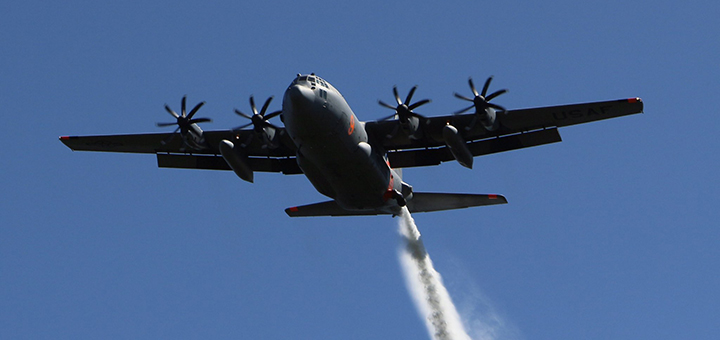Other News Releases
Media Contacts:
NIFC: Stanton Florea 208-387-5437
[email protected]
AFNORTH: Lt Col Karen Roganov 850-774-1044
[email protected]
California Air National Guard, Nevada Air National Guard and USDA Forest Service conduct annual aerial firefighting training
San Bernardino, Calif., April 29, 2021 – The California Air National Guard’s 146th Airlift Wing and the Nevada Air National Guard’s 152nd Airlift Wing will join the USDA Forest Service, the Bureau of Land Management and other firefighting agencies for aerial wildland firefighting training May 3-7 at the San Bernardino Airtanker Base.
“The Modular Airborne Fire Fighting System (MAFFS) program provides an important supplement to our national airtanker capacity,” said Kim Christensen, deputy assistant director for operations for the USDA Forest Service. “Our partnership is successful year-after-year due to the commitment of both the federal wildland fire agencies as well as our military partners.”
The C-130s equipped with MAFFS are essentially converted into airtankers and provide a critical “surge” capability that can be used to augment wildfire suppression efforts. MAFFS are only activated when all commercial airtankers that are part of the national airtanker fleet are fully committed or not readily available.
The aircraft will be doing practice water drops in remote areas of the Angeles National Forest. Residents in the area may see low-flying C-130 aircraft and U.S. Forest Service lead planes throughout the week. MAFFS aircraft will load water at San Bernardino and travel to drop zones on the Angeles National Forest for the practice drops.
The 146th Airlift Wing and 152nd Airlift Wing C-130 Hercules aircraft are equipped with the U.S. Forest Service’s MAFFS, which can drop up to 3,000 gallons of fire retardant in less than 10 seconds across a quarter-mile line. The system slides into the back of the military aircraft, and retardant is released through a nozzle on the rear left side. MAFFS aircraft can be activated to supplement the USDA Forest Service and the civilian airtanker program to slow or stop the spread of wildland fires across the nation. The Department of Defense can provide up to eight MAFFS equipped aircraft, as required.
“Certification training allows these units to refine their processes and helps cement our working relationships with NIFC and other agencies. It is critical training that helps ensure the entire team is postured and prepared to deliver critical firefighting capability,” said Lt. Gen Kirk Pierce, commander, U.S. Air Forces Northern. “Summer 2021 is projected to be a busy wildland fire season, so the training and command relationships are critical to our mission to protect life and property.”
The 153rd Airlift Wing from Cheyenne, Wyoming and the 302nd Airlift Wing, Peterson Air Force Base, Colorado, are also part of the AEG MAFFS program and will be participating in certification training the following week in Colorado.
The certification trainings, sponsored by the USDA Forest Service, include classroom sessions, flying and ground operations for Air Force aircrews, civilian lead plane pilots and support personnel from the USDA Forest Service, Bureau of Land Management and other state and federal firefighting agencies.
For background photos and videos of the MAFFS program, visit: www.dvidshub.net/feature/MAFFSAEG.
###









